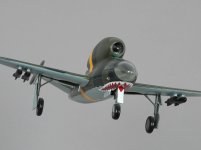Gunn Miniatures
Command Sergeant Major
- Joined
- Jun 18, 2009
- Messages
- 2,853
WOW542 Blackburn Buccaneer
The Blackburn Buccaneer, later officially known as the Hawker Siddeley Buccaneer when Blackburn became a part of the Hawker Siddeley Group. The Buccaneer entered service in the 1962 and was designed to have exceptional low-altitude performance, the Blackburn Buccaneer was one of the most capable aircraft of its kind and was originally designed in response to the Soviet Union’s Sverdlov-class cruiser construction program.
Instead of building a new fleet of its own, the Royal Navy could use the Buccaneer to attack these ships by approaching at low altitudes below the ship’s radar horizon. The Buccaneer could attack using a nuclear bomb, or conventional weapons. It was later intended to carry short-range anti-shipping missiles to improve its survivability against more modern ship-based anti-aircraft weapons.
The subsonic strike jet was the heaviest aircraft ever operated by the Royal Navy on an aircraft carrier.
There was a decision by the UK government in the 1960s to phase out fixed wing operations as HMS Hermes was slated to become a "Commando Carrier" for Royal Marine operations (similar in concept to a US Navy LHA).
The RAF later inherited the Buccaneer from the Royal Navy but adoption and use by the Royal Air Force was not straightforward. Firstly, they did want to use the Buccaneer as a replacement for the English Electric Canberra, due to low speed and lack of range. Plus the RAF were looking at using the more advanced BAC TSR-2 bomber, but this aircraft project was cancelled as was the proposed second choice, the General Dynamics F-111K.
It was therefore decided in 1968 that the RAF would adopt the Buccaneer.
The Buccaneer served in the first Gulf War in 1991 with the RAF and saw service with the South African Airforce, the only other operator. The ending of the Cold War led to a reduction in RAF strength, the last Buccaneer was retired in 1994, to be replaced by the Tornado.
Our new and very large 1/30 scale Mahogany Buccaneer S.2C in a 'squirrel grey' colour scheme and served with No 801 Naval Air Squadron at RAF Lossiemouth in Scotland and also onboard HMS Hermes. The squadron eventually disbanded at Lossiemouth on 21 July 1970. In January 1981 the squadron re-equipped with the Sea Harrier FRS.1 at RNAS Yeovilton and went on to serve with distinction in the Falklands War.
We only have one x 1/30 scale model available priced at $999 plus postage.




That's all for this month for our aircraft, we sincerely hope you enjoy the pictures and would love to hear from you if any of these magnificent models appeal to you.
Best wishes The Gunn Team
The Blackburn Buccaneer, later officially known as the Hawker Siddeley Buccaneer when Blackburn became a part of the Hawker Siddeley Group. The Buccaneer entered service in the 1962 and was designed to have exceptional low-altitude performance, the Blackburn Buccaneer was one of the most capable aircraft of its kind and was originally designed in response to the Soviet Union’s Sverdlov-class cruiser construction program.
Instead of building a new fleet of its own, the Royal Navy could use the Buccaneer to attack these ships by approaching at low altitudes below the ship’s radar horizon. The Buccaneer could attack using a nuclear bomb, or conventional weapons. It was later intended to carry short-range anti-shipping missiles to improve its survivability against more modern ship-based anti-aircraft weapons.
The subsonic strike jet was the heaviest aircraft ever operated by the Royal Navy on an aircraft carrier.
There was a decision by the UK government in the 1960s to phase out fixed wing operations as HMS Hermes was slated to become a "Commando Carrier" for Royal Marine operations (similar in concept to a US Navy LHA).
The RAF later inherited the Buccaneer from the Royal Navy but adoption and use by the Royal Air Force was not straightforward. Firstly, they did want to use the Buccaneer as a replacement for the English Electric Canberra, due to low speed and lack of range. Plus the RAF were looking at using the more advanced BAC TSR-2 bomber, but this aircraft project was cancelled as was the proposed second choice, the General Dynamics F-111K.
It was therefore decided in 1968 that the RAF would adopt the Buccaneer.
The Buccaneer served in the first Gulf War in 1991 with the RAF and saw service with the South African Airforce, the only other operator. The ending of the Cold War led to a reduction in RAF strength, the last Buccaneer was retired in 1994, to be replaced by the Tornado.
Our new and very large 1/30 scale Mahogany Buccaneer S.2C in a 'squirrel grey' colour scheme and served with No 801 Naval Air Squadron at RAF Lossiemouth in Scotland and also onboard HMS Hermes. The squadron eventually disbanded at Lossiemouth on 21 July 1970. In January 1981 the squadron re-equipped with the Sea Harrier FRS.1 at RNAS Yeovilton and went on to serve with distinction in the Falklands War.
We only have one x 1/30 scale model available priced at $999 plus postage.




That's all for this month for our aircraft, we sincerely hope you enjoy the pictures and would love to hear from you if any of these magnificent models appeal to you.
Best wishes The Gunn Team
Last edited:

















